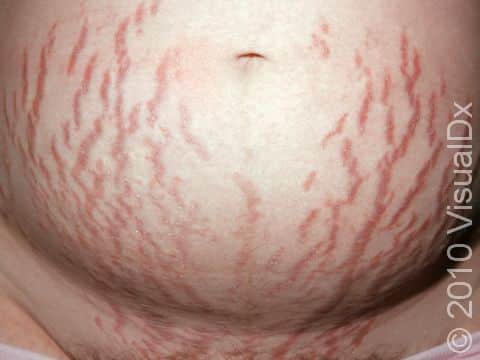Stretch Marks of Pregnancy (Striae of Pregnancy)
Striae gravidarum, commonly known as stretch marks in pregnancy, occurs in many pregnant individuals. They are primarily due to the rapid rate at which the skin is being stretched, combined with pregnancy hormones.
Who's At Risk?
Stretch marks in pregnancy usually occur during the second or third trimester, when the baby is growing the most. They occur more often in younger individuals, those carrying large infants, and in individuals who are overweight or obese. People with family members who had stretch marks during pregnancy are also at higher risk of getting stretch marks during their pregnancy.
Signs & Symptoms
Stretch marks in pregnancy most commonly occur on the belly but can appear on the buttocks, breasts, thighs, and upper arms.
When they first occur, stretch marks appear as faint pink or brownish, raised, band-like marks that can be itchy. They gradually enlarge and become red to purple, often with a wrinkled surface. Finally, stretch marks become white or light, slightly flatter, with a crepe-paper-like appearance. The linear marks can be 1-10 mm wide and several centimeters long.
Self-Care Guidelines
There are numerous products on the market that claim to help prevent stretch marks, but there is no accepted consensus among specialists. Massaging the skin with ointment or cocoa butter may be beneficial at preventing stretch marks. Over-the-counter products that are marketed for fading or removing stretch marks are generally considered ineffective.
Treatments
Most stretch marks will become smaller postpartum and over time will fade to pale flesh- or silver-colored. Following your pregnancy, your medical professional may prescribe topical tretinoin cream (eg, Retin-A) or oral tretinoin to treat dark stretch marks. These medications should not be used without using two forms of birth control, as they have been found to cause birth defects, and they should not be used by lactating individuals. Laser treatment or chemical peels may be helpful in lightening stretch marks, but they are associated with some risks.
Visit Urgency
No treatment is necessary for stretch marks, and they usually fade after delivery (postpartum). See your medical professional if you are concerned about the appearance of the stretch marks and want to talk about options for treating your stretch marks. Note, however, that no treatments fully eliminate the appearance of stretch marks.
Trusted Links
References
Bolognia J, Schaffer JV, Cerroni L. Dermatology. 4th ed. Philadelphia, PA: Elsevier; 2018.
Kang S, Amagai M, Bruckner AL, et al. Fitzpatrick’s Dermatology. 9th ed. New York, NY: McGraw-Hill Education; 2019.
Last modified on January 26th, 2024 at 1:17 pm

Not sure what to look for?
Try our new Rash and Skin Condition Finder
